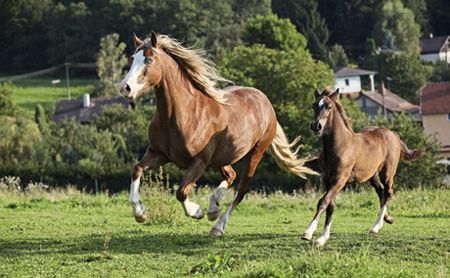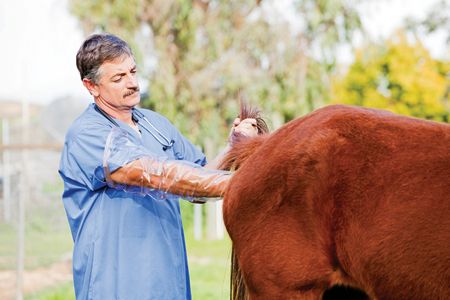Investigating early embryonic loss in mares
Discover which potential risk factors are the most likely culprits in your equine veterinary patients-and how to manage them.

Getty Images/Zuzule
Speaking at last December's American Association (AAEP) of Equine Practitioners Conference in Salt Lake City, Dirk Vanderwall, DVM, PhD, DACT, discussed the etiology of early embryonic loss in mares with about 120 practitioners in attendance. This article outlines some the group's key discussion points.
Early embryonic loss occurs between fertilization and 60 days of gestation, according to Vanderwall, associate professor and head of Utah State University's Animal, Dairy and Veterinary Sciences department. To monitor a mare's progression and identify signs of early pregnancy loss, he says it's typical to do a transrectal ultrasonographic examination on a routine basis. The first pregnancy examination and twin pregnancy check should be done between 14 and 16 days. If a mare is confirmed pregnant at that time, then it's common to do the first follow-up examination between 25 and 30 days to find a heartbeat. Practitioners typically do additional checks at 45 days and 60 days, covering the period of time for potential early pregnancy loss.
With older mares, which have a greater likelihood of early pregnancy failure, Vanderwall recommends following the examination schedule outlined above or checking even more often-every 10 days during the breeding season. Routine ultrasound, he says, has no adverse effect on pregnancy and is safe even in older mares.
Etiology factors
In his 2008 paper about early embryonic loss, Vanderwall discussed etiologies, including intrinsic, extrinsic and embryonic factors.1 At the AAEP meeting this past December, he didn't review all of this material, although he and the large group of attendees did discuss several key points.
Intrinsic factors
> Endometrial disease, both inflammatory and non-inflammatory. Inflammatory disease includes acute and chronic endometritis, while non-inflammatory disease includes periglandular fibrosis and endometrial cysts, which are most commonly dilated lymphatics.1
> Progesterone insufficiency.1 The group talked about the use of altrenogest (Regu-Mate-Merck Animal Health) or native progesterone supplementation to try to maintain pregnancy, as well as the need to monitor blood progesterone. “The group consensus in Salt Lake City was that 4 ng/ml of blood progesterone was the desired blood progesterone concentration,” Vanderwall says. “If it's less than that, we generally agreed that supplementation with exogenous progestin would be warranted. However, because of the need to collect serial blood samples to definitively identify low progesterone concentration, many pregnant mares are prophylactically administered progestin, which makes progesterone supplementation a fairly controversial topic.”
> Maternal age. It's well-documented that older mares have higher early pregnancy loss rates. “All things considered, declining oocyte quality seems to be the biggest age-related factor in causing an increase in pregnancy loss in older mares,” Vanderwall says. “By the time they're into their late teens and older, it's a big factor causing higher embryonic loss rates.”
At the AAEP meeting, the group discussed maternal age as a key issue. Unfortunately, “at this time there's not a lot we can do about higher embryonic loss rates in older mares, but we must recognize its importance,” Vanderwall says. “If we closely monitor those pregnancies with ultrasound, we can hopefully recognize problems early enough in the breeding season so there's another opportunity to re-breed that mare and re-establish pregnancy.”
> Lactation It's possible that the energy demands of lactation and hormonal changes associated with lactation could affect the incidence of early embryonic loss.1
> Foal-heat breeding. There's conflicting data on the effect of foal-heat breeding on the incidence of early embryonic loss,1 and AAEP attendees also expressed conflicting thoughts on this approach. “There were those who advocated foal-heat breeding if the foaling was normal and there were no issues with the mare or foal,” Vanderwall says. “Others said they preferred to bypass foal-heat and ‘short-cycle' her with prostaglandin into an early second heat. Those dealing with thoroughbreds seemed to be less inclined to foal-heat breeding than those breeding quarter horses at foal-heat with artificial insemination.”
> Time of insemination relative to ovulation. The insemination of mares after ovulation occurs has been associated with an increased incidence of early embryonic loss. This connection may be due to delayed embryonic development, according to Vanderwall.1
> Site of intrauterine fixation on the embryonic vesicle. The embryonic vesicle is subjected to extensive intrauterine motility from the time it first becomes evident with transrectal ultrasonography on day 10 or 11 through day 16, at which time the vesicle becomes “fixed” in the base of one of the uterine horns, Vanderwall says. “Fixation is thought to occur because of interaction between increasing uterine tone, increasing size of the embryonic vesicle and a physical impediment to further movement caused by the sharp curvature or flexure of the uterine horns at this point.”1 Embryos that become “fixed” in the caudal uterine body rather than one of the horns have a higher rate of pregnancy failure.
> Maternal chromosome abnormalities. Teri Lear, PhD, from the University of Kentucky's Gluck Equine Center, suggests in her research that chromosomal abnormalities such as translocations may have a greater influence on equine fertility than previously reported for repeated early embryonic loss and that subfertile mares should be karyotyped to rule out chromosomal abnormalities.2 In addition, Lear emphasizes that it's important to use all available comparative mapping tools to analyze these clinical cases. The results not only shed light on the causes of infertility in horses but can provide clues to unravel the evolutionary history of equid chromosomes.2
This issue was further discussed at the meeting. “Lear identified in her work that some mares with repeated early pregnancy failure have karyotypic abnormalities,” Vanderwall says. “They've got subtle chromosomal translocations, where one part of a chromosome gets clipped off and attached to another chromosome. Historically, X-monosomy (or Turner's syndrome), the most common chromosomal abnormality in mares that is characterized by the absence of one X chromosome, is associated with profound primary infertility because of a complete absence of cyclical reproductive activity. However, as clearly shown by Lear, more subtle forms of chromosomal abnormalities can be associated with repeated early embryonic loss.”1
These subtle karyotypic abnormalities were causing mares to be “subfertile.” “It's important to recognize, based on Lear's work, that if veterinarians can't find any other underlying reason for recurring pregnancy loss, it may warrant having the karyotyping done by a specialized reference laboratory, like the Gluck Equine Center at the University of Kentucky, to test a mare for potential karyotypic abnormalities,” Vanderwall says. “That was the key take-home point from our discussion regarding chromosomal abnormalities.”
Extrinsic factors
> Stress. Stress associated with severe pain, infectious disease and weaning may contribute to endocrine changes in pregnant mares, which may lead to early embryonic loss.1
“One of the issues that came up in the meeting was the social stress young mares face leaving their racetrack routine and trying to adjust to their new life as a broodmare,” Vanderwall says. Attendees also discussed that the stress of transportation early in pregnancy might be a factor for early embryonic loss. “There is no convincing evidence that routine transportation of mares during early gestation has any adverse effect on maintenance of early pregnancy,” Vanderwall says. “However, attendees discussed that this may be a factor on an individual basis. If a particular mare doesn't tolerate shipping well, transporting her during early gestation may require more caution.”
> Nutrition. In a seminal study on nutrition and fertility in mares cited in Vanderwall's 2008 study,1 mares fed to lose body condition from 90 days prepartum to foaling and then fed to maintain low body condition until 90 days post-foaling showed a significantly lower per-cycle pregnancy rate. And the pregnancy loss rate between days 30 and 90 was significantly higher. “In addition, when compared across treatment groups, mares in the study that foaled with a body condition score less than 5.0 had significantly lower pregnancy rates, and none of the mares that were maintained with a condition score of less than 5.0 after foaling were pregnant at 90 days of gestation.”1 Researchers concluded that “to maximize reproductive efficiency and minimize early embryonic loss, mares should receive good-quality feedstuffs in sufficient quantity to maintain optimum body condition.”1
> Season or climate. In horses, there is no clear-cut evidence of an environmental effect on early embryonic loss because the date of ovulation or establishment of pregnancy has been shown to be no different for mares that maintained pregnancies versus those that lost pregnancies.1 It was noted that significantly higher early embryonic loss rates occurred for mares bred in February and March versus those bred later in the season (in the Northern Hemisphere). However, rather than a true seasonal effect, these results could reflect that a higher proportion of the mares bred early in the season were barren, which would likely include more aged mares, resulting in higher loss rates.1
> Transrectal palpation and ultrasonography. There was no effect of either on early embryonic loss.
> Sire. In Vanderwall's research, there was no statistically significant effect of the stallion on pregnancy loss rates between days 22 and 44.1 However, “regarding ‘the stallion factor,' some veterinarians in the audience expressed that certain stallions seemed to produce pregnancies with a higher rate of early pregnancy failure than other stallions,” Vanderwall says. “There is not a lot of data in the literature about the effect of stallions on early embryonic loss, but there is some. And this was confirmed, at least anecdotally, from the veterinarians at the meeting.” Some attendees indicated that they had periodically dealt directly with stallions that produced pregnancies with a higher pregnancy failure rate. “It might possibly be genetic, chromosomal or some characteristic of that stallion,” Vanderwall says, “We don't really know.”

The first pregnancy examination and twin pregnancy check should be done between 14 and 16 days, says Dirk Vanderwall, DVM, PhD, DACT. If a mare is confirmed pregnant at that time, then it's common to do the first follow-up examination between 25 and 30 days to find a heartbeat. (Getty Images/Alina Solovyova-Vincent)
Embryonic factors
Increasing maternal age is clearly associated with decreased oocyte quality, which may reflect chromosomal or other inherent changes within the oocyte that apparently do not affect fertilization rates but dramatically increase the incidence of early embryonic loss in aged mares.1
Conclusion
The bottom line, Vanderwall says, is to “pamper the older mare,” as she is particularly predisposed to early pregnancy loss. “Several factors, be they chromosomal, poor oocyte health, stress or nutrition, all may especially affect the older mare,” he says. “If an individual older mare has the capability to become pregnant, monitoring her closely during early gestation is warranted in order to identify embryonic loss if it occurs, so she can potentially be re-bred.”
References
1. Vanderwall DK. Early embryonic loss in the mare. J Equine Vet Sci 2008;28(11):691-702.
2. Lear TL, Lundquist J, Zent WW, et al. Three autosomal chromosome translocations associated with repeated early embryonic loss (REEL) in the domestic horse (Equus caballus). Cytogenetic Genome Res 2008;120(1-2):117-122.
Ed Kane, PhD, is a researcher and consultant in animal nutrition. He is an author and editor on nutrition, physiology and veterinary medicine with a background in horses, pets and livestock. Kane is based in Seattle.
Podcast CE: A Surgeon’s Perspective on Current Trends for the Management of Osteoarthritis, Part 1
May 17th 2024David L. Dycus, DVM, MS, CCRP, DACVS joins Adam Christman, DVM, MBA, to discuss a proactive approach to the diagnosis of osteoarthritis and the best tools for general practice.
Listen